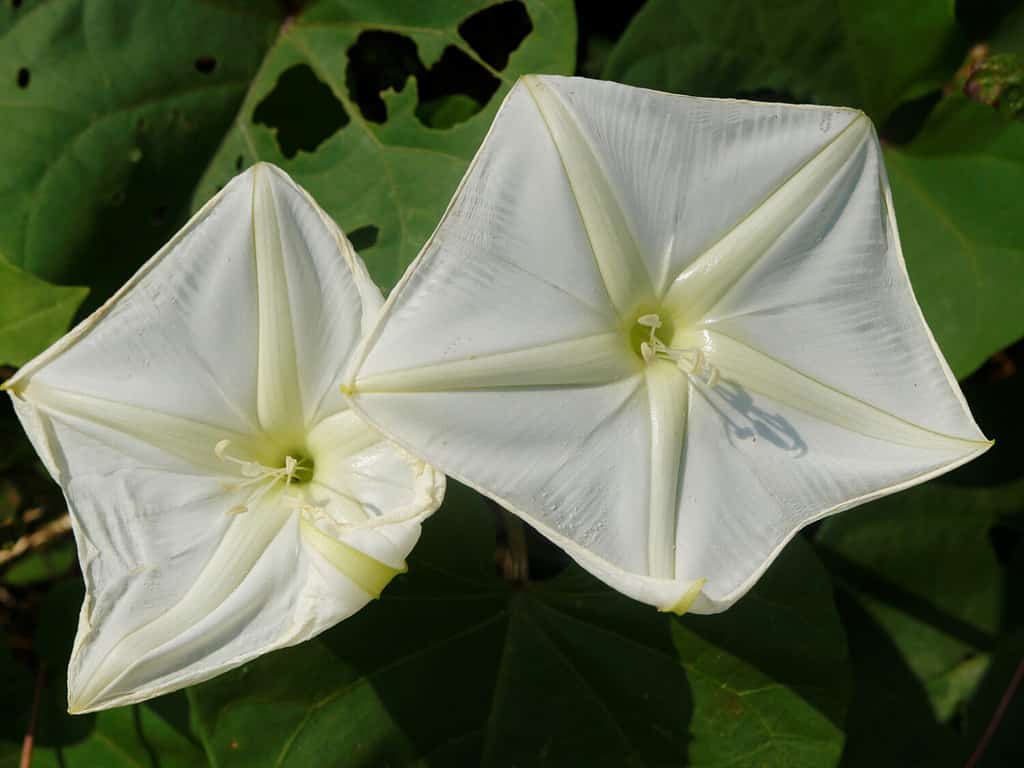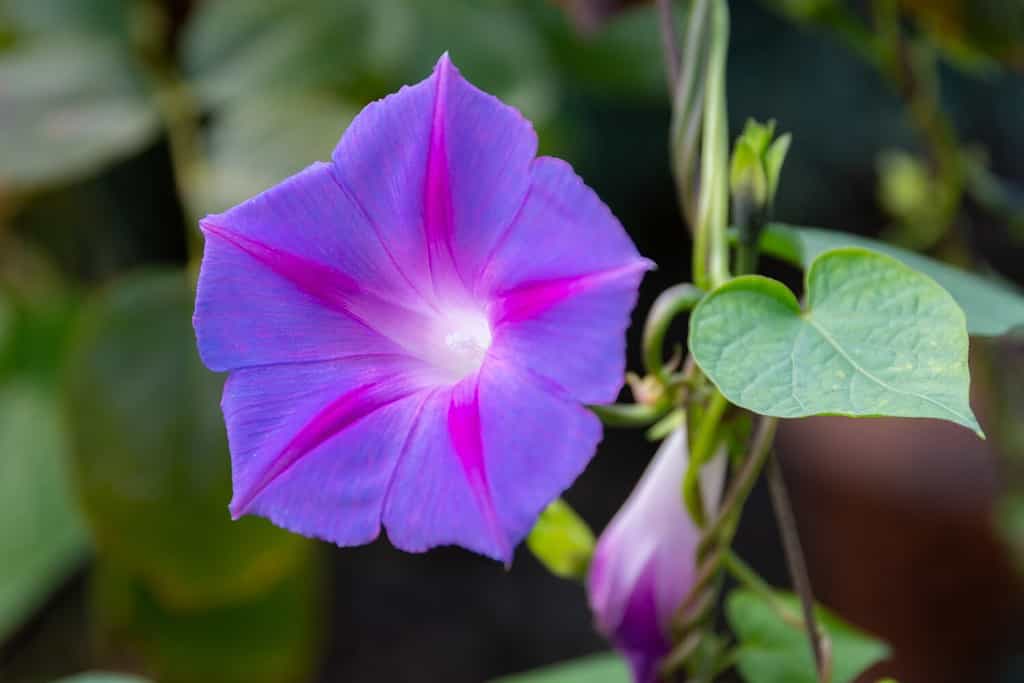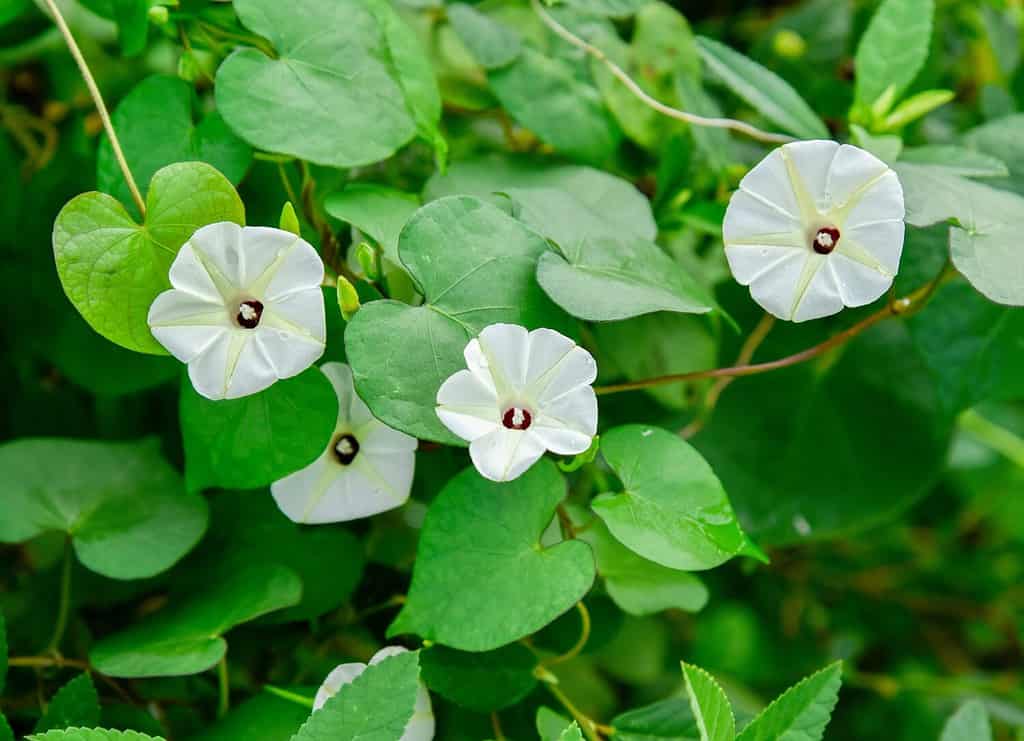It can be hard to know what kind of flower you just found based on looks alone, especially when so many of them look so similar. With thousands of species of flowers under hundreds of genera, it is understandable we might get some confused with others. This is particularly true of the moon flower and the morning glory. If you found a flower that looks like one of these types, how can you figure out which one it is? We’re here to help you identify the moon flower vs morning glory.
What is The Moon Flower?

Note the bright white flower and symmetrical pattern of the moon flower. These petals will close in the morning around dawn.
©ziedonis/Shutterstock.com
The plant known as the moon flower (or moonflower) is also known as the moon vine, tropical white morning glory, and its scientific name Ipomoea alba. The fact that one of its names includes morning glory definitely adds to the confusion between the moon flower and the common morning glory. They are a specific species of the Ipomoea genus.
The moon flower is a night-blooming plant (hence the name) and is native to North and South America as well as the West Indies. It is known for its large white flowers that might resemble the moon, though they can also be pink. They will bloom quickly in the evening before closing when the morning new accumulates on their petals.
Moon flowers are tropical plants, so it is hard to grow them outside a tropical climate. However, they also do not grow in places where the days are too long since they bloom at night. They require long nights to grow and populate properly. The moon flower grows so well in some tropical areas that they have named it an invasive species that overgrows and can destroy farming lands and other natural habitats.
Facts about moon flowers
Interestingly, the native American societies of Mesoamerica used the moon flower, along with the latex from the Panama Rubber Tree to create the first bouncing rubber balls! The Olmecs did this around 1600 BCE, which is three thousand years before modern society learned how to produce hardened rubber.
You can recognize a moon flower vine by its large, white flowers (usually only open at night). These flowers have five sections, and the leaves are large, dark green, and have one heart-shaped section. If you are in the areas in or around Arizona, Florida, Argentina, or Mexico, you can find these plants pretty easily.
What is The Morning Glory?

A purple variety of morning glory, open after the rising of the sun. This is one of thousands of species of morning glory.
©CoinUp/Shutterstock.com
Morning glory is a name casually applied to over a thousand different species of flowers. All these flowers belong to the family Convolvulaceae, which includes the genus Ipomoea (of which the moon flower described above is a species). There are around 60 genera and over 1,650 species of flowers which we can call morning glories. Interestingly, not all the plants we call morning glories are flowering vines, but also herbs, shrubs, and even trees! Even the sweet potato is a member of the morning glory family. (If you have a home garden with sweet potatoes, take a look at their blossoms next time and you’ll see!)
Facts about morning glories
Many people harvest and process the seeds of morning glories to use as purgatives. Other species of morning glories are used as ingredients in some psychedelic substances after they have been infected by ergot. The Aztecs have numerous records of them using morning glories for this purpose. Specifically, they used the morning glory known as the Christmasvine or snakeplant.
Since there are many different types of morning glory, you should be careful when picking one for your home garden. Some are known as beautiful, showy, and impressive garden staples, while others are treated as invasive, troublesome, and annoying weeds. In Australia, for example, one species of morning glory is able to grow thick roots and grow quickly over the land via long vines. They smother other plants and are treated as a hostile, invasive weed. The problem with morning glories destroying other plants is so bad that most species are actually illegal to grow, sell, and even possess in Arizona. Other states classify some morning glories as noxious plants. Morning glories are particularly dangerous to cotton crops.
You can recognize the blossoms of a morning glory by their funnel-shaped flower and radially symmetrical petals. They got their name, morning glory, from their tendency to bloom with the rising sun. They unfurl from their spiral form in full sunlight, before winding back into a tight cone at sundown.
Other uses for morning glories
However, other morning glories are grown exclusively for their medicinal use. The Chinese used morning glories thousands of years ago as a natural medicine and as an effective laxative. As with all plants, however, consult with a local expert before you begin harvesting morning glories for your own home remedies.
Morning glories have other useful purposes, also. They are a favorite with some gardeners when used to create summer shade on trellises. They grow fast and are great at blocking out the sun. Morning glories are also a particularly favorite flower in Japan. As far back as the Nara Period and into the Edo Era all the way to today, the morning glory was raised as a favorite hobby flower. This gave rise to the now-famous Japanese morning glory.
Besides the sweet potato, another edible species of morning glory includes water spinach. This is popularly grown in Texas and Asia.
Moon Flower Vs Morning Glory

The bright whiteness of the flower and the heart-shaped leaves are the best indicators of the moon flower.
©Thao Lan/Shutterstock.com
Because morning glories include the genus Ipomoea, the moon flower is also technically a type of morning glory. You would not be incorrect to refer to the moon flower as morning glory unless you were trying to differentiate between two different morning glories. The local use of morning glory to refer to specific types of Convolvulaceae or Ipomoea can and will change depending on where you are. So being clear on what flower you mean, and being specific and knowledgeable about the species, can go a long way to reducing confusion.
For this reason, it might be hard to distinguish a moon flower from other white varieties of morning glory. But here are a few things to keep in mind.
First, the blossoms of the moon flower are typically only open at night. Most other morning glories, as their name implies, are open during the day. Second, moon flowers are exclusively white (except for some rare pink-hued varieties). If you have a flower of any other color, then it is not going to be a moon flower. Third, the blossoms of the moon flower are usually 3–5 inches in diameter and the plant itself can grow to between 16–100 feet tall if left unchecked. Finally, moon flowers will not grow in places where the days are too short, or the weather too cold.
Conclusion
That’s the moon flower vs morning glory! In the end, if the flower doesn’t remind you of the moon when you see it at night, then it probably isn’t a moon flower. If you want a moon flower for your garden, it’s best to learn to identify them by sight or ask an expert at a garden center or a native to the area familiar with the local plants. All morning glories are notorious fast growers and will overtake any garden if left to their own devices, so make sure you are ready!
Thank you for reading! Have some feedback for us? Contact the AZ Animals editorial team.








